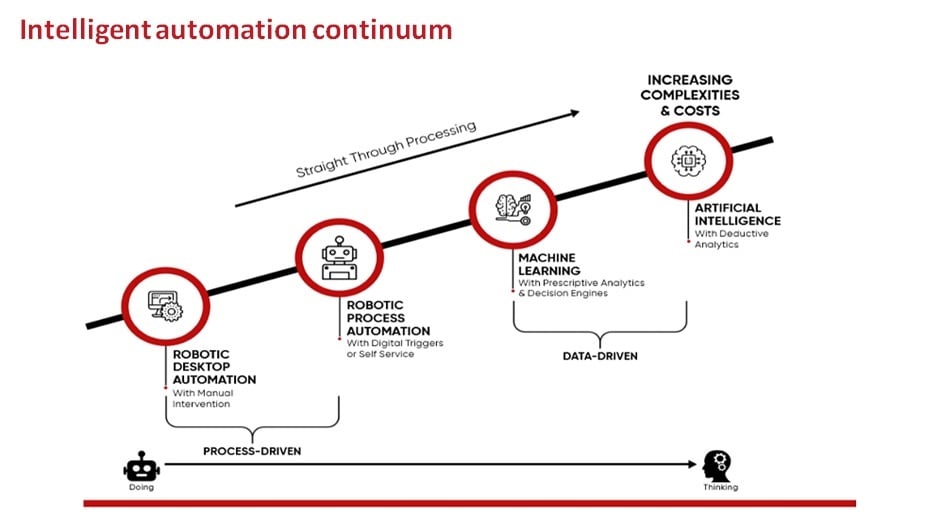Time to adopt a platform approach to automation by leveraging the intelligent automation platform
by Saurabh Sharma, on Apr 6, 2021 3:45:52 AM
As the low-hanging opportunity for task automation via RPA is gradually reduced, enterprises are realizing that end-to-end process automation is the Holy Grail for solving a myriad of business and IT issues. Whether it is about optimizing a decade-old process or ensuring that the need for human intervention for tackling unstructured data is reduced, a platform approach to automation is gaining ground. This is not about ad hoc solutions used as Band-Aids to solve recurring process automation issues, rather such an approach focuses on delivering a greater degree of automation at an end-to-end process level.
The value proposition of an intelligent automation platform
Intelligent automation in simpler terms is a paradigm wherein artificial intelligence (AI) and machine learning (ML) capabilities are used to add “intelligence” to simple rules-based processing delivered by discrete automation tools, such as RPA. While euphemistically, simple RPA bots can do dumb processing quite well, they are unable to process anything that lies outside the boundaries of defined rules, and in an ideal world, enterprises would not want to follow the route of traditional BPM-style case management.
This is where AI/ML capabilities provide the capabilities to process semi-structured and unstructured data and move beyond simple rules-based processing. While this type of intelligence is still not comparable to human-like thinking, it still helps in improving the extent of automation in an end-to-end process. Take the case of IDP solutions, here pre-built AI/ML capabilities and business rules enable automated verification and validation of data. Continuous learning & improvement based on AI/ML algorithms and user inputs and cognitive capabilities combined together to deliver a greater percentage of straight-through processing (STP) with higher accuracy, thereby reducing manual effort and saving time. This is a good example of intelligent automation.

The ground reality is that in the case of such end-to-end process automation, users are following a mix of process- and data-driven approaches to automation. For example, users can achieve end-to-end automation by ingesting unstructured data from documents and its conversion to structured data using RPA and IDP in combination. By combining process- and data-driven approaches to automation, users can handle more complex use cases and achieve a greater degree of automation, as the focus is on both “doing/execution” and “thinking” aspects of processing. In simple terms, this is the value proposition of an intelligent automation platform. Some of the core characteristics of such an intelligent automation platform include component-level APIs for easy integration, unified user experience (UX), and greater ease of use for different user personas, namely developers and less-skilled business users.
Handling complex use cases with ease using the intelligent automation platform
Take the example of another complex use case. A major bank was looking to automate what was a manual verification process for loan approval/rejection, and of course, a tedious & data-intensive process. One of the tasks in this process was to scan for bad press, and that itself is a cumbersome process for a case worker. Using RPA and AI/ML tools in combination, the bank was able to reduce data compilation time to 10 minutes from 3-4 days, thereby enabling faster decision-making. Moreover, no manual intervention was needed by the underwriting team. In this case, RPA was used for automated data scraping from various sources, resulting data was extracted using various techniques, semantic analysis & lexicon analyses were performed to get accurate search results, and subsequently automated credit worthiness reports were prepared. Clearly, this level of automation could not be achieved using discrete automation tools and this again is a good example of process automation delivering a clear business value.
Another good case in point is that of a US bank. They were looking to digitize 30 million documents and were in the process of acquiring six smaller banks. Using a combination of RPA, intelligent document processing (IDP), and AI/ML tools, the bank was able to digitize, index, summarize, and classify these millions of documents in about six weeks. This helped reduce operational expenditure by 50% and achieve auto-classification with 98% accuracy. There is a clear business impact of automation in this case and such type of complex use cases cannot be handled using piecemeal approaches to automation.
What is the future of intelligent automation platforms?
Today, the business requirement is to go beyond a piecemeal approach to automation and leverage end-to-end automation. The intelligent automation platform addresses automation holistically. It adds intelligence to simple rule-based automation by strategically leveraging AI/ML layers and handles more complex business use cases. The intelligent automation platform approach will only continue to grow in the future to bring more autonomy to business automation.













